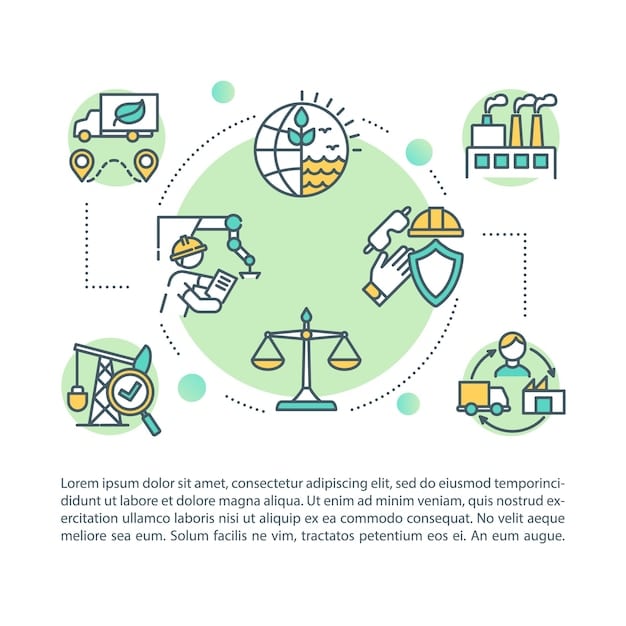New US Labor Laws 2025: Are Businesses Ready for Cost Increases?

Navigating the landscape of New Labor Laws in 2025 is crucial for businesses in the US, as upcoming regulations are poised to reshape operational costs and compliance requirements, demanding proactive preparation.
As we approach 2025, a significant shift in the US labor landscape is on the horizon. Businesses across various sectors are bracing for the impact of **new labor laws in 2025: are you prepared for the changes and potential cost increases?** Understanding these impending regulatory adjustments is not just about compliance; it’s about strategic foresight and maintaining a competitive edge in a constantly evolving economic environment.
Understanding the Regulatory Landscape of 2025
The year 2025 is set to bring about substantial changes in US labor regulations, impacting businesses of all sizes. These aren’t just minor adjustments; they represent a significant recalibration of rights, responsibilities, and operational parameters for employers and employees alike. Proactive understanding and adaptation are key to mitigating adverse effects and even identifying new opportunities.
The legislative momentum behind these new laws stems from a variety of factors, including evolving economic conditions, shifting societal expectations regarding work-life balance, and renewed focus on worker protections and equity. Policymakers are responding to pleas for fairer wages, safer working conditions, and clearer guidelines on emerging employment models, such as the gig economy. This comprehensive approach aims to create a more equitable and stable labor market, but it introduces complexities for businesses.
Anticipated Federal and State-Level Reforms
While specific details are still being finalized, general trends indicate a push towards increased minimum wages, expanded paid leave benefits, and stricter enforcement of classification rules for independent contractors. States often act as laboratories for new policy, and many are exploring measures that could later influence federal legislation. Businesses operating across multiple states must be vigilant about regional variations.
- Minimum Wage Hikes: Several states and municipalities are already slated to increase their minimum wage, with potential federal actions also being discussed. This directly impacts payroll costs.
- Expanded Paid Leave: New mandates for paid sick leave, family leave, and even bereavement leave are gaining traction, requiring businesses to adjust their benefits packages and accrual policies.
- Independent Contractor Reclassification: Stricter tests for determining independent contractor status are being proposed to curb misclassification, which can lead to significant penalties for employers.
These changes reflect a broader governmental effort to bolster worker protections and ensure more equitable labor practices. For businesses, this means a need for meticulous review of current employment contracts, compensation structures, and classification methodologies. Ignoring these developing regulations could lead to significant legal and financial repercussions.
The challenge for businesses lies in anticipating these shifts and building flexible, compliant frameworks. This involves not only legal scrutiny but also strategic HR planning and financial forecasting to absorb potential cost increases without compromising profitability or operational efficiency. Early insights into these reforms allow for necessary adjustments in budgeting and human capital strategies.
Projected Financial Impacts on Businesses
The advent of new labor laws in 2025 carries significant financial implications for businesses across the US. Beyond mere compliance, these regulations are poised to directly influence operational budgets, necessitating a careful review of financial models and strategic planning. The cumulative effect of increased wages, expanded benefits, and heightened compliance burdens could reshape expense reports for many organizations.
One of the most immediate and tangible impacts will be on payroll expenses. Mandated minimum wage increases, particularly for businesses that rely heavily on entry-level or service-sector roles, will translate directly into higher labor costs. This isn’t just about the hourly rate; it also affects overtime calculations, payroll taxes, and potentially even benefits tied to a percentage of wages. Businesses must calculate these compounding effects.
Beyond Payroll: Benefits and Compliance Costs
The expansion of paid leave mandates adds another layer of financial complexity. Employers will need to budget for additional paid time off, which can lead to increased staffing needs (e.g., hiring temporary workers to cover absences) or reduced productivity if existing staff are stretched thin. These benefits, while crucial for employee well-being, represent a direct increase in the total compensation package.
- Healthcare Contributions: New mandates or changes to existing ones could increase employer-provided healthcare costs, especially if new requirements necessitate more comprehensive plans.
- Training and Education: Businesses may need to invest in new training programs to ensure managers and HR personnel are fully aware of and compliant with the updated regulations. This includes legal counsel expenses.
- Administrative Overhead: Tracking and administering new paid leave policies, reclassifying employees, and ensuring accurate record-keeping will demand more time and resources from HR and legal departments.
Furthermore, stricter enforcement regarding employee classification can result in significant financial penalties if missteps occur. Back wages, fines, and legal fees associated with misclassification lawsuits can be substantial. Businesses that historically have leaned on independent contractors for flexibility may need to re-evaluate these arrangements and potentially transition some roles to full-time employment, incurring associated benefits costs.
The collective sum of these changes means businesses must adopt a proactive budgeting strategy. This includes scenario planning to understand the best and worst-case financial outcomes. Some may opt to adjust pricing, explore automation, or optimize other operational expenses to absorb these increased labor costs. The financial health of a company in 2025 will largely depend on its ability to forecast and adequately prepare for these projected increases.

Strategic HR Adjustments for 2025
Navigating the new labor laws in 2025 requires more than just financial forecasting; it demands a comprehensive overhaul of human resources strategies. HR departments will play a pivotal role in ensuring compliance, managing employee relations, and adapting company culture to the evolving regulatory environment. Strategic HR adjustments are critical to not only avoid penalties but also maintain a productive and motivated workforce.
A key area of focus for HR will be policy review and update. All employee handbooks, contracts, and internal policies must be rigorously examined against the backdrop of the new legislation. This includes updating language around work hours, overtime, leave policies, and classification of workers. Clear and concise communication of these changes to employees is paramount to avoid confusion and potential disputes.
Talent Acquisition and Retention Strategies
The new regulations may also influence talent acquisition and retention efforts. Increased minimum wages and expanded benefits could make certain roles more attractive, but they also necessitate a review of overall compensation packages to ensure competitiveness. Businesses might need to adjust their hiring profiles or even their geographical recruiting efforts to align with new cost structures.
- Revising Compensation Scales: HR must work with leadership to adjust pay scales to remain competitive while adhering to new minimum wage and pay equity laws.
- Enhancing Benefits Offerings: Beyond mandated benefits, consider offering additional perks to attract and retain talent in a more competitive labor market.
- Employee Training & Upskilling: Invest in training programs to upskill current employees, increasing their value and potentially reducing the need for new, higher-cost hires.
Furthermore, employee classification diligence will become even more critical. HR teams must work closely with legal counsel to clearly define roles, responsibilities, and the nature of employment relationships, particularly for those working in hybrid or remote capacities, or those previously classified as independent contractors. Misclassification can lead to severe back pay, tax liabilities, and fines, making this a top priority.
Effective change management within the organization falls squarely on HR’s shoulders. This involves educating employees and managers about the new rules, addressing concerns, and fostering an environment of transparency and fairness. A well-informed workforce is more likely to adapt smoothly to changes, minimizing disruption and maintaining morale. Proactive HR leadership can transform compliance challenges into opportunities for strengthening the employer-employee relationship.
Technological Solutions for Compliance
As businesses prepare for the complexities introduced by the new labor laws in 2025, leveraging technology will become indispensable for ensuring compliance and managing increased operational demands. Manual processes often fall short in accuracy and efficiency, making digital solutions a necessary component of a robust compliance strategy.
Modern HR and payroll software, for instance, can automate many of the laborious tasks associated with tracking hours, calculating overtime, administering benefits, and managing leave requests. These systems are designed to integrate the latest regulatory changes, reducing the burden on HR staff and minimizing the risk of errors that could lead to non-compliance violations. The right software can provide real-time data and reporting, allowing for better visibility into labor costs.
Software to Streamline Operations and Ensure Accuracy
Payroll systems with built-in compliance modules are particularly valuable. They can automatically apply new minimum wage rates, manage complex overtime rules, and calculate required payroll taxes. This automation is crucial for businesses with a diverse workforce or those operating in multiple jurisdictions with varying labor laws. The accuracy provided by these systems mitigates the risk of fines and legal challenges.
- Automated Time Tracking: Systems that automatically record employee work hours, breaks, and leave requests reduce human error and ensure compliance with wage and hour laws.
- Benefits Administration Platforms: Software that simplifies the enrollment, management, and tracking of employee benefits, including new paid leave entitlements, is essential.
- Compliance Reporting Tools: Generate accurate reports that demonstrate adherence to local, state, and federal labor laws, supporting audits and legal defense.
Beyond payroll and HR, other technological solutions can support compliance efforts. For instance, communication platforms can disseminate updated policies efficiently, while project management tools can help track compliance projects and deadlines. Data analytics tools can also provide insights into areas of potential risk or opportunity related to labor costs and productivity, guiding strategic decisions.
The investment in appropriate technology is not merely an expense; it’s an investment in risk mitigation and operational efficiency. By automating and streamlining compliance processes, businesses can free up valuable human resources to focus on more strategic initiatives, such as talent development and employee engagement. Embracing technology proactively ensures that businesses not only meet the new legal requirements but also operate more intelligently and adaptively in the face of regulatory change.

Negotiating with Unions and Workforce Planning
In the context of the new labor laws in 2025, negotiation and workforce planning take on heightened importance, especially for businesses with unionized employees or those potentially facing unionization efforts. The evolving legal framework significantly impacts collective bargaining agreements and strategic staffing decisions, demanding a more nuanced and informed approach.
For unionized workplaces, the new laws will undoubtedly be a central theme in upcoming collective bargaining negotiations. Unions will likely leverage enhanced worker protections and expanded benefits to seek more favorable terms for their members, potentially pushing for higher wages, more generous leave policies, and clearer independent contractor definitions within their contracts. Employers must come to the table prepared with detailed financial projections and a clear understanding of the new legal landscape to negotiate effectively and sustainably.
Strategic Workforce Management in a Changing Environment
Beyond union negotiations, comprehensive workforce planning is crucial for all businesses. This involves assessing current staffing levels, skill sets, and organizational structures against future needs and regulatory requirements. Businesses may need to re-evaluate their reliance on temporary workers, part-time staff, or independent contractors in light of stricter classification rules, potentially shifting to more full-time employment model.
- Succession Planning: Identify and develop internal talent to fill critical roles, reducing reliance on external hires who may come at a higher cost under new regulations.
- Automation Assessment: Evaluate where automation or AI can supplement human labor, potentially offsetting rising wage costs and increasing efficiency.
- Flexible Work Arrangements: Explore remote or hybrid work models where feasible, which can sometimes reduce overhead costs and improve employee satisfaction, but also require careful policy adjustments.
The new legal environment also presents an opportunity for businesses to proactively review their employee relations strategies to deter potential unionization efforts in non-unionized settings. By offering competitive wages, robust benefits, and fostering a positive work environment that aligns with or exceeds the new legal standards, businesses can preemptively address common reasons employees seek union representation.
Ultimately, successful workforce planning in 2025 will involve a delicate balance between legal compliance, financial prudence, and employee well-being. By engaging in strategic negotiations and meticulous workforce planning, businesses can adapt to the new labor landscape without compromising their operational effectiveness or long-term growth prospects. This proactive approach ensures stability and resilience in the face of significant change.
Communicating Changes to Employees and Stakeholders
Effective communication is a cornerstone of navigating the new labor laws in 2025. As businesses implement changes to comply with these regulations, transparent and consistent communication with employees, management, and other stakeholders is vital to minimize confusion, alleviate anxiety, and maintain trust. Miscommunication or a lack of information can lead to rumors, resentment, and a decline in morale.
For employees, clarity regarding changes to their wages, benefits, work schedules, and classification is paramount. It’s not enough to simply update policies; businesses must explain the “why” behind the changes, detailing how the new laws impact individual roles and overall company operations. This can be achieved through multiple channels, including town hall meetings, detailed memos, updated employee handbooks, and dedicated HR support sessions.
Ensuring Clarity and Transparency Across the Organization
Management teams also require comprehensive training and clear directives to effectively implement and communicate these changes downstream. Managers are often the first point of contact for employee questions and concerns; therefore, they must be fully informed and equipped to provide accurate and consistent information. Their understanding and support are critical for a smooth transition.
- Dedicated Information Hub: Create a central repository (e.g., an intranet page) for all information related to the new labor laws, including FAQs, updated policies, and contact information for HR.
- Regular Updates: Provide ongoing updates as new details emerge or as the company progresses through implementation phases. Transparency builds confidence.
- Open Dialogue: Establish clear channels for employees to ask questions and provide feedback, fostering a sense of involvement and addressing concerns proactively.
Beyond internal communication, businesses should also consider how to inform their external stakeholders, such as investors, partners, and customers. While the primary focus is internal, major shifts in operational costs or employment practices could be of interest to these groups. A well-crafted message can reassure investors about financial stability and partnership continuity.
Ultimately, a robust communication strategy about the new labor laws in 2025 transforms a compliance challenge into an opportunity to reinforce company values and commitment to its workforce. By proactively engaging with all stakeholders, businesses can navigate the changes with minimal disruption, fostering a resilient and informed organizational culture ready for future challenges. This proactive approach cultivates a more adaptive and stable business environment.
Adapting Business Models for Future Resilience
The impending new labor laws in 2025 present not just a compliance challenge but a crucial opportunity for businesses to re-evaluate and adapt their fundamental models for long-term resilience. Rather than simply reacting to mandates, forward-thinking organizations will strategically adjust operations to thrive in the new regulatory environment, aiming for sustainable growth and profitability.
One key area for adaptation is cost management beyond immediate labor expenses. While wage and benefit increases are direct impacts, businesses can explore efficiencies in other areas such as supply chain optimization, energy consumption, and technology adoption. Investing in automation, for example, can offset rising labor costs by increasing productivity and reducing reliance on manual processes in certain areas.
Innovation and Efficiency as Pillars of Adaptation
Pricing strategies may also need a review. If labor costs become significantly higher, businesses might need to adjust the pricing of their products or services to maintain profit margins. This requires careful market analysis to ensure competitiveness while absorbing increased expenses. Alternatively, some businesses might focus on delivering higher-value services or products that justify a higher price point.
- Diversification of Services: Explore new revenue streams or diversify service offerings that are less labor-intensive or command higher margins.
- Local vs. Global Sourcing: Re-evaluate sourcing strategies; sometimes local sourcing can reduce transportation costs, while international might offer cost benefits despite other complexities.
- Digital Transformation Initiatives: Accelerate digital adoption across all departments to streamline workflows, reduce administrative overhead, and improve decision-making.
Furthermore, businesses should consider their geographical footprint. Differences in state and local labor laws might make some regions more cost-effective for expansion or relocation. This does not mean abandoning current locations, but rather strategically planning future growth with regulatory costs in mind. Talent availability and cost-of-living factors will also play a role in these strategic decisions.
Ultimately, adapting business models for future resilience involves a holistic approach. It’s about leveraging innovation, optimizing operational efficiency, and making informed strategic decisions that go beyond mere compliance. Businesses that proactively embrace these changes, viewing them as catalysts for improvement and innovation, are those most likely to thrive in the dynamic economic landscape of 2025 and beyond.
| Key Area | Brief Description |
|---|---|
| 📊 Labor Costs | Anticipate direct increases from minimum wage hikes and expanded benefits. |
| ⚖️ Compliance Risks | New rules demand HR policy updates and careful employee classification to avoid penalties. |
| 💻 Tech Solutions | Leverage HR/payroll software for automation and accuracy in managing new requirements. |
| 🗣️ Communication | Crucial for transparency with employees and stakeholders during the transition. |
Frequently Asked Questions About 2025 Labor Laws
▼
The primary areas of change include potential increases in minimum wage thresholds, expansions of paid leave entitlements (such as sick leave and family leave), and stricter guidelines for classifying independent contractors versus employees. These changes are aimed at enhancing worker protections and ensuring equitable labor practices across industries. Businesses should review federal and state-specific updates closely.
▼
The new labor laws are expected to increase operational costs through higher payroll expenses due to increased wages, expanded benefits packages, and potential administrative costs associated with new compliance requirements. Businesses may also face penalties for non-compliance or misclassification, necessitating careful budgeting and financial forecasting to absorb these potential increases effectively.
▼
Businesses should conduct comprehensive reviews of their employee handbooks, compensation structures, and classification policies. Strategic HR adjustments include revising pay scales, enhancing benefits offerings, investing in compliance training for staff, and potentially re-evaluating the use of independent contractors. Proactive communication with employees about these changes is also critical for maintaining morale.
▼
Absolutely. Modern HR and payroll software can significantly assist with compliance by automating tasks like time tracking, overtime calculation, benefits administration, and accurate record-keeping. These technological solutions reduce human error, streamline operations, and offer real-time reporting to ensure adherence to new labor regulations, protecting businesses from potential fines and legal issues.
▼
Effective communication is crucial for a smooth transition. Businesses must transparently communicate changes to their employees, managers, and other stakeholders through various channels. This includes explaining impacts on wages, benefits, and job roles. Clear, consistent information minimizes confusion, addresses concerns proactively, and builds trust, fostering a more resilient and informed organizational culture.
Conclusion
The
new labor laws in 2025 represent a transformative moment for businesses across the US. While the prospect of increased costs and complex compliance challenges can seem daunting, proactive preparation, strategic adaptation, and effective communication are essential. By embracing technological solutions, adjusting HR strategies, and maintaining open dialogues with employees and external stakeholders, businesses can not only meet these new demands but also emerge stronger and more resilient. The ability to anticipate, adapt, and innovate will define success in this evolving regulatory landscape, turning potential obstacles into opportunities for sustainable growth.





